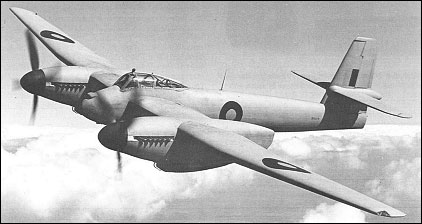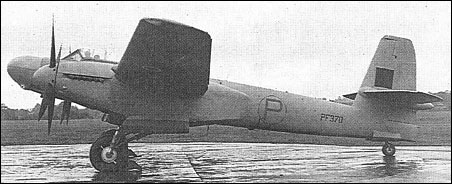|
| On 9 January 1941, Westland was authorised by the Ministry of Aircraft Production to proceed with two prototypes of its P.14 design for a twin-engined high-altitude fighter, in compliance with Specification F.4/40. Conceived as a two-seater with six 20-mm cannon armament, the P.14 went ahead as a four-cannon single-seater with a pressurized cockpit. Revised to conform to F.7/41, and thus competing with the Vickers Type 432, the P.14, to be named the Welkin, first flew on 1 November 1942. The wing was located in the mid position, and power was provided by two Rolls-Royce Merlin Mk 61s of 1,565 hp, these being succeeded by 1,650 hp Merlin 72/73 or Merlin 76/77 in the production Welkin I. Pressurization of the cockpit was achieved by means of a Rotol blower on the starboard engine. Production of the Welkin I was initiated in 1941, contracts for 100 and then 200 being placed, and the first series aircraft was under test at Boscombe Down by mid-September 1943. However, handling problems combined with reduced operational interest in high-altitude fighters led to cancellation of production after the completion of 75, plus 26 airframes without engines. The Welkin I saw no service use.
Welkin NF Mk II
During 1943, Westland studied a number of possible derivatives of the Welkin I in order to take advantage of the design work already completed. Of these possibilities, one for a two-seat night fighter variant received a go-ahead on 4 February 1943, subsequent development of this as the Welkin NF Mk II being in accordance with Specification F.9/43. Two prototypes were ordered, as conversions of Mk I airframes during production, and orders were given for 60 of the final production batch of Mk Is to be to this standard. As flown on 23 October 1944, the prototype Welkin NF Mk II introduced AI Mk VIII radar in a lengthened bulbous nose and a new one-piece canopy over a two-seat cockpit in which the observer faced aft behind the pilot. Production plans for the Welkin NF Mk II were cancelled during 1945, along with those for the F Mk I, and the second prototype was not completed.
 | A three-view drawing of Welkin Mk 1 (800 x 546) |
| MODEL | Welkin Mk 1 |
| WEIGHTS |
| Take-off weight | 8970 kg | 19776 lb |
| Empty weight | 6520 kg | 14374 lb |
| DIMENSIONS |
| Wingspan | 21.34 m | 70 ft 0 in |
| Length | 12.65 m | 42 ft 6 in |
| Height | 4.65 m | 15 ft 3 in |
| Wing area | 42.73 m2 | 459.94 sq ft |
| PERFORMANCE |
| Max. speed | 623 km/h | 387 mph |
| Ceiling | 13410 m | 44000 ft |
| Range | 2400 km | 1491 miles |
| Paul Scott, e-mail, 26.01.2015 16:41 Another fine design, though as many have said, a thick wing was not conducive to the performance needed. reply | | F Starr, e-mail, 15.01.2014 18:01 Thickness chord ratio on the Welkin was 21%, a high value even by WWII standards. Mach number effects were encounters between 60-65% of the speed of sound according to Perrin in the Anglo-American Aeronautical Conference of 1947 reply | | Colin Leighfield, e-mail, 28.09.2012 18:15 This is a fascinating aeroplane and I've learned everything I can about it. Odd how great designers like Petter and Camm took so long to grasp the relationship between wing section thickness and compressibility when Mitchell had clearly understood it so much earlier. The dive limits of the Hurricane were already well understood in 1940, so Camm should have seen the writing on the wall for the Tornado /Typhoon as an interceptor fighter even then. Even more amazing that Spitfires were flown as high as 50,000 ft. The Spitfire VII was probably a more competent high altitude fighter than the Welkin could ever have been, but even that was hardly needed because the Germans didn't adopt the high altitude bombing strategy that had been expected of them. I've built a 1 /12 scale model of Welkin Mk.1 and it looks really good. Perhaps the most telling summary of it is that of Eric Brown in "Wings of the Wierd and Wonderful". reply |
| neiyi, 20.06.2011 14:18 Without the problem of the Mach No effects, the combination of thick wing, high aspect ratio, and high wing loading would have been optimum for a high altitude fighter. reply | |
| | Tom Chytil, e-mail, 07.12.2010 22:10 In the thin air at 42,000 feet and with a high wing loading, the maximum speed was probably not much higher than the stall speed. I would imagine that the controls had to be managed rather carefully at that altitude. This is a problem common to many high altitude aircraft. reply | | Walter McGowan, e-mail, 07.08.2010 06:21 This plane was the main design effort during the War.
It had two blown Griffon engines, and the gun bay under the fuselage had four cannons, I think they were 35 mm.
Having to design the pressurized system from scratch, it gave rise to a new company called Normalair. Their patents became known world wide.
Flying at 42,000 ft. was very new in 1942-1943. Harold Penrose was fascinated to see all of S.W. England, down to Cornwall framed in his windshield. reply | | F Starr, e-mail, 15.06.2008 20:31 The main problem with this aircraft is that is had a thick wing by the standards of the time and a relatively high wing loading. A thick wing would have led to a low critical Mach No, which would have been exacerbated by the fact that at high altitude the high wing loading would have necessitated the wing working at a high lift coefficient....A high lift coefficient results in an increased high local airspeed over the wing.
The Welkin may be regarded as a good example of the tendency of Petter,the designer, at Westland to take curent aerodynamic knowledge to the extreme. Without the problem of the Mach No effects, the combination of thick wing, high aspect ratio, and high wing loading would have been optimum for a high altitude fighter.
Petter learnt from his mistakes and his next design ,the Canberra, was the antithesis of the Welkin. Low aspect ratio, relatively thin wing, and low wing loading.As a result the Canberra attained the world altitude record on three occasions reply | | Andy Hoskins, e-mail, 03.06.2008 00:05 You might like to look at www.military.cz /british /air /war /fighter /welkin /welkin_en.htm where it is suggested that the engines and propellers proved troublesome and follow up by reading Harald Penrose's book "No Echo in the Sky". Penrose experienced just such a problem but managed to land on one engine before the other became completely wrecked when the propeller raced out of control and failed to feather. reply | | Graham Berry, e-mail, 16.01.2007 17:37 My fathers late cousin Sqn Ldr Joseph Berry DFC** flew the Welkin on several occasions when he was with the FIU in 1943 /4. He flew this aircraft up to 40,000 ft +.
I would like to know more about the development of this aircraft. reply |
|
Do you have any comments?
|
| 
COMPANY
PROFILE
All the World's Rotorcraft
|









Although some Spitfires were capable of reaching 50,000ft, performance at that high altitude would have been marginal to say the least, and not comparable to an aeroplane designed to operate at such heights.
reply